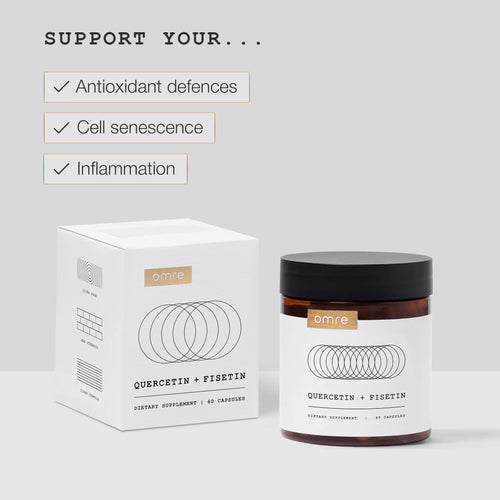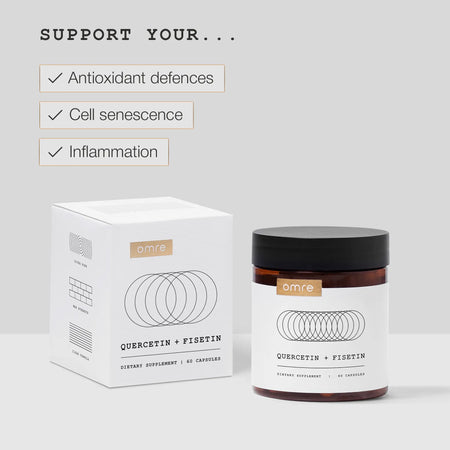Table of Contents
- TL;DR
- How Long Does It Take Quercetin to Work?
- Understanding the Timeline: Quercetin's Action Across Different Uses
- Factors Influencing Quercetin's Timeline of Action
- Realistic Timeline Expectations for Quercetin Benefits
- Tips to Potentially Expedite Quercetin's Action
- Is Quercetin Safe? What You Should Know
- Conclusion
- FAQs
- Move Better, Feel Stronger, Live Longer
If you’ve started taking quercetin, you’re probably wondering when the benefits will show up. Whether you’re using it for allergy relief, inflammation, or immune support, how long quercetin takes to work depends on the reason you're taking it and how consistently you use it. This quick guide breaks down what to expect, how fast it might work, and how to make the most of it.
Quercetin + Fisetin
Quercetin and Fisetin help manage 'zombie' senescent cell burden and support cellular rejuvenation.*
TL;DR
Here’s a quick overview of how long quercetin usually takes to work, depending on the health goal:
How Long Does It Take Quercetin to Work?
-v1750786829076.webp) Some people may notice relief from allergy symptoms within a few hours to a couple of days. For longer-term goals like reducing inflammation or supporting immunity, it usually takes several weeks of consistent daily use.
Some people may notice relief from allergy symptoms within a few hours to a couple of days. For longer-term goals like reducing inflammation or supporting immunity, it usually takes several weeks of consistent daily use.
Quercetin works differently depending on the issue you're addressing. For short-term problems like allergy flare-ups, its effect on histamine release and mast cells may provide relatively fast relief. But if you're using it to manage inflammation or support your immune system, it's more of a slow build.
Most of quercetin’s long-term benefits, such as antioxidant protection and improved immune resilience, are cumulative. You may not feel anything right away, but at the cellular level, it's helping your body respond better over time.
Bottom line: If you're expecting overnight results, quercetin may not be the right fit. But if you're in it for the long haul, it can be a smart and supportive addition to your health routine.
Understanding the Timeline: Quercetin's Action Across Different Uses
To accurately answer "How long does it take for quercetin to work?", we need to consider the diverse ways people use quercetin and the typical timeframes associated with each application. Quercetin's effects are not instantaneous; they unfold over different durations depending on the health goal.
Allergy Relief: Within Hours to a Few Days
If you’re taking quercetin for allergies, this is where it may work the fastest. Some people notice relief from sneezing, itchy eyes, or a runny nose in just a few hours. For others, it might take two to three days of consistent use.
This quick response happens because quercetin helps stabilize mast cells, which are responsible for releasing histamine, the main trigger behind allergy symptoms. By calming those cells down, quercetin acts like a natural antihistamine, though it's not quite as fast as common over-the-counter allergy meds.
Tip: For better results, try taking quercetin regularly before allergy season begins. It tends to work best as a preventative, helping your body stay ahead of the reaction rather than chasing it after symptoms get bad. That said, even if you start during an active flare-up, many people still find it helps within a couple of days.
Immune Support: 2 to 6 Weeks
If you're hoping to support your immune system with quercetin, give it time. You’re unlikely to notice big changes overnight. Most people need at least 2 to 6 weeks of daily use to experience noticeable benefits.
Quercetin helps your immune system by regulating how immune cells respond and calming inflammation that can interfere with defense mechanisms. It may also support the body’s response to viruses by making it harder for them to enter cells.
Some people start taking quercetin at the first sign of a cold or flu, and while it’s not a cure, it might help reduce the severity or duration of symptoms. Still, the best results often come from taking it consistently, not just when you're already sick.
Chronic Inflammation: 4 to 8 Weeks or More
For long-term inflammation, think of quercetin as a slow but steady helper. It takes time to shift how your body handles inflammatory responses. Most people won’t feel real changes for several weeks—sometimes even a couple of months.
Quercetin works by reducing oxidative stress and blocking inflammatory signals at the cellular level. That’s not something you feel instantly, but over time, it may lead to less joint pain, reduced swelling, or better mobility if you're dealing with inflammatory issues like arthritis.
And here’s the kicker: quercetin works even better when you combine it with an anti-inflammatory lifestyle. Eating clean, staying active, getting good sleep, and managing stress all help maximize its benefits.
Antioxidant Protection: Ongoing, Subtle Effects
Quercetin is also a powerful antioxidant, but this is where patience matters most. Unlike allergy relief, you won’t feel its antioxidant effects. What it’s doing is helping to protect your cells from long-term damage caused by free radicals.
This protection builds up slowly. It supports healthy aging, better energy over time, and possibly lowers your risk for certain chronic conditions. But don’t expect any dramatic, short-term shifts.
The key here is consistency. Taking quercetin every day builds a layer of cellular defense that can benefit your body in the long run, even if the results are more about prevention than quick wins.
Factors Influencing Quercetin's Timeline of Action
 Quercetin doesn’t work the same for everyone. How quickly you feel the effects depends on a mix of things, from dosage and formulation to your metabolism and health goals. Here’s what makes the biggest difference:
Quercetin doesn’t work the same for everyone. How quickly you feel the effects depends on a mix of things, from dosage and formulation to your metabolism and health goals. Here’s what makes the biggest difference:
1. Dosage: Higher Isn’t Always Better
Taking more quercetin might speed things up, but only to a point.
Larger doses may help for short-term needs like allergy relief. You might notice effects faster, especially in the first few days.
Lower doses take longer to work but are often easier on your body, making them a better fit for long-term use.
The ideal dose depends on your goal. A therapeutic dose for allergies might not be the same as one for long-term inflammation or immune support.
Always check the label and talk to a healthcare provider before adjusting your dose.
2. Formulation & Bioavailability: Not All Quercetin Is Equal
Your body absorbs some forms of quercetin much better than others.
Standard quercetin has low bioavailability, meaning most of it gets broken down before your body can use it.
Enhanced formulas like quercetin phytosome or micronized quercetin are designed to absorb better and faster. These may work more quickly, especially for acute needs like allergies.
If you're looking for faster effects, go for a high-bioavailability option.
3. Your Body: Metabolism, Gut Health, and Genetics
Everyone processes supplements differently.
Fast metabolism? You might feel results sooner.
Gut issues? Poor digestion can reduce how much quercetin you absorb, slowing its benefits.
Genetics also play a role. Some people naturally respond better or faster due to differences in how they break down flavonoids.
If your results are slower than expected, it doesn’t necessarily mean it’s not working—it may just take longer for you.
4. Your Health Goal: Fast for Allergies, Slower for Chronic Issues
What you’re using quercetin for makes a big difference in the timeline.
Acute issues like allergy flare-ups may respond within hours to a few days.
Chronic conditions like joint inflammation or immune support usually take several weeks, or even months, of consistent use.
Short-term problems tend to respond faster, while long-term issues require more patience and regular intake.
5. Consistency: Daily Use Beats “Once in a While”
If you want results, consistency matters more than timing.
Daily use helps build up quercetin levels in your system, allowing its effects to accumulate.
Occasional use won’t deliver the same benefits, except maybe for short-term allergy support.
Quercetin isn’t something to take just when you remember. It works best when it becomes part of your daily routine, especially for inflammation, immune health, and long-term protection.
Quercetin + Fisetin
Quercetin and Fisetin help manage 'zombie' senescent cell burden and support cellular rejuvenation.*
Realistic Timeline Expectations for Quercetin Benefits
To set realistic expectations for "how long it takes for quercetin to work," consider these typical timelines:
Short-Term (Days to 2 Weeks) Potential Outcomes
Reduced Allergy Symptoms: Noticeable decrease in sneezing, runny nose, itchy eyes, and skin reactions in some individuals within days of starting quercetin for allergy relief.
Initial Anti-inflammatory Relief: Mild reduction in pain, swelling, or discomfort associated with minor inflammatory issues might be felt within the first week or two for some.
General Sense of Wellbeing: Some individuals might experience a subtle increase in energy or overall sense of well-being within the first few weeks, though this is subjective.
Medium-Term (2 Weeks to 2-3 Months) Potential Outcomes
Sustained Allergy Management: Continued and more pronounced relief from allergy symptoms throughout the allergy season with consistent quercetin use.
Measurable Anti-inflammatory Improvements: Potential for measurable reductions in blood markers of inflammation (e.g., CRP levels) in some individuals with chronic inflammatory conditions, assessable through lab testing.
Enhanced Immune Resilience: Possible reduction in the frequency or severity of common infections over time with sustained immune support from quercetin.
Noticeable Symptom Improvement in Chronic Conditions: Gradual but noticeable improvement in symptoms related to chronic inflammatory conditions (e.g., joint pain, skin issues, digestive discomfort) may become apparent after several weeks to a few months of consistent quercetin use, especially when combined with other lifestyle and medical approaches.
Long-Term (3+ Months and Beyond) Potential Outcomes
Sustained Antioxidant Protection: Ongoing cellular protection against oxidative stress, contributing to long-term cellular health, healthy aging, and reduced risk of chronic diseases associated with oxidative damage (primarily preventative and not directly felt in the short-term).
Maintenance of Immune and Inflammatory Balance: Continued support for a balanced and resilient immune system and reduced chronic inflammation over the long term, as part of a comprehensive healthy lifestyle.
Support for Healthspan and Longevity: Potential contribution to overall healthspan and lifespan in the context of a health-promoting lifestyle, based on epidemiological and mechanistic evidence about flavonoids and antioxidants (very long-term, preventative, and part of a holistic approach to wellness).
Tips to Potentially Expedite Quercetin's Action
While quercetin's timeline is inherently gradual for many of its benefits, you can optimize your intake to potentially enhance its effectiveness and speed of action to some extent:
Choose High Bioavailability Formulations
Select quercetin supplements formulated for enhanced bioavailability, such as quercetin phytosome or micronized quercetin, to potentially improve absorption and achieve faster, more noticeable effects, especially at lower dosages.
Take Quercetin Strategically with Food
Consume quercetin supplements with meals, particularly those containing healthy fats. This can significantly improve quercetin absorption, as it is a fat-soluble compound and dietary fats aid in its uptake from the digestive tract.
Combine with Synergistic Supplements
Consider combining quercetin with synergistic nutrients that may enhance its effects or bioavailability. Potentially beneficial combinations include:
Vitamin C: May enhance quercetin's antioxidant actions and potentially improve its absorption.
Bromelain: An enzyme from pineapple that may have complementary anti-inflammatory effects and some believe might enhance quercetin absorption (though evidence is limited).
Zinc: As a zinc ionophore, quercetin enhances zinc's cellular uptake, making this a synergistic combination, particularly for immune support and antiviral activity.
Maintain Daily Consistency and Optimal Dosage
Ensure consistent daily intake of quercetin at an appropriate dosage for your needs and goals. Following product label instructions and consulting with a healthcare professional for personalized dosage guidance is recommended for optimizing results.
Adopt a Holistic Healthy Lifestyle
Quercetin's benefits are often amplified when integrated into a broader healthy lifestyle. Prioritize:
Anti-inflammatory Diet: Focus on a diet rich in fruits, vegetables, whole grains, and healthy fats, while minimizing processed foods, added sugars, and unhealthy fats.
Effective Stress Management: Implement stress-reduction techniques like mindfulness, meditation, yoga, or spending time in nature to reduce chronic stress and support overall health.
Regular Physical Activity: Engage in regular exercise to reduce inflammation, support immune function, and enhance overall well-being, which can synergize with quercetin's benefits.
Prioritize Quality Sleep: Ensure adequate, restful sleep to support immune function, reduce inflammation, and optimize the body's natural repair and regeneration processes.
Is Quercetin Safe? What You Should Know
For most people, quercetin is safe and well-tolerated, especially when taken at standard doses found in supplements. But like with any supplement, there are a few things to keep in mind.
Mild Side Effects Are Rare
Quercetin doesn’t usually cause problems, but very high doses might lead to mild symptoms like headaches, nausea, or a tingling feeling. These effects are uncommon and typically go away on their own.
Watch for Medication Interactions
If you’re taking prescription medications, especially blood thinners or drugs processed by the liver (through cytochrome P450 enzymes), check with your doctor first. Quercetin might interfere with how certain medications are broken down, though more research is still needed.
Extra Caution for Specific Groups
Pregnant or breastfeeding? There’s not enough research yet to confirm quercetin’s safety during these periods, so it’s best to avoid it unless your doctor says otherwise.
Kidney issues? Some early studies suggest high doses could affect kidney function, so if you have a kidney condition, consult your doctor before use.
Bottom Line
Quercetin is generally safe for daily use, but if you’re on medications or managing a health condition, it’s smart to speak with a healthcare provider before starting, especially if you plan to take higher doses.
Conclusion
Quercetin isn’t a quick fix, but it can be a steady, reliable support when used consistently. If you’re taking it for allergies, you might feel better within a day or two.
For conditions such as inflammation or immune health, expect a longer timeline, typically a few weeks to a few months of daily use.
The key is to stay consistent. Choose a well-absorbed formula if you want quicker results, especially for short-term needs. Pair it with healthy habits like good nutrition, regular movement, and sleep, and you'll give your body the best chance to benefit.
If you’re managing a health condition or taking medication, it’s always smart to check with your doctor before starting. Used thoughtfully, quercetin can be a valuable part of your long-term wellness routine.
FAQs
How long does it take quercetin to work for allergies?
It may take 1 to 4 weeks of daily use to see relief from allergy symptoms, especially for seasonal allergies. Effects build up over time as it reduces histamine response.
Can quercetin work immediately?
Not usually. Quercetin isn’t fast-acting like antihistamines. Some mild effects might show within hours, but consistent use is needed for noticeable results.
Can you take quercetin every day?
Yes, quercetin is generally safe for daily use. Most studies use 500 to 1,000 mg per day. Talk to your doctor if you're on medications or have health conditions.
How long before quercetin helps inflammation?
Some anti-inflammatory effects may begin within a few days, but noticeable results often take 2 to 4 weeks with regular use.
Does quercetin work immediately?
Not immediately. It's not a quick fix, but rather works gradually by modulating inflammation and histamine release over time.
What helps quercetin work faster?
Taking quercetin with fat or a bioenhancer like vitamin C or bromelain may improve absorption and speed up benefits. Consistent daily use also matters.
Move Better, Feel Stronger, Live Longer
Don’t let inflammation, sluggish recovery, or aging hold you back. Whether you're an active senior wanting to keep moving, an immune-conscious individual looking for extra support, or an athlete recovering from tough workouts, Quercetin + Fisetin helps your body function at its best.
This powerful duo works at the cellular level to promote resilience, fight inflammation, and support longevity, so you can keep doing what you love.
Stay strong, stay active, and take control of your health today!






